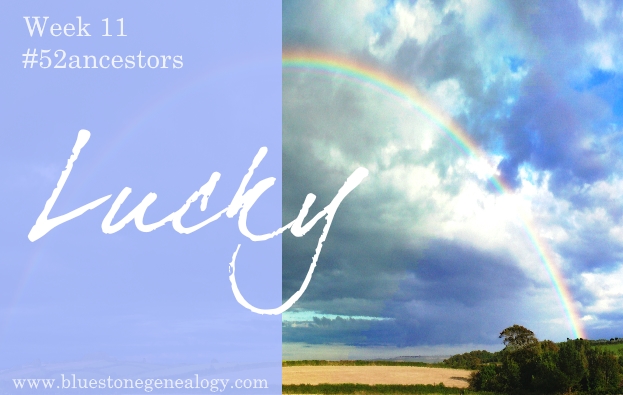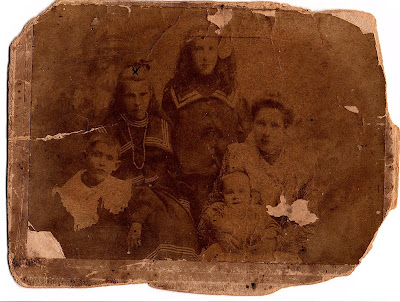Strong Woman...
Happy International Women's Day! Today's blog post continues to tell the story of my 3x great grandmother, Catherine Devitt who was raised during the Great Famine in Ireland. At age 20, when she was 2 months pregnant, she began the arduous journey in search of a better life, which brought her to Melbourne, Australia. If you missed last weeks post, I suggest reading that prior to continuing. You can find that post here : Week 9 - Where There's a Will...
What became of Catherine and Ann Fitzgerald Devitt after they left
the Immigration Depot is unknown however, on 2 March 1859 Catherine married
widower James Logan, a sailor from Greenock, Scotland in John Knox Presbyterian
Church on Swanston Street. The ceremony was conducted by William Miller, and witnessed
by William Page, and Catherine’s younger sister Ann Lowrie (nee Devitt) who had arrived in Melbourne two years prior. While
neither Catherine nor James list any children on their marriage certificate,
they had at least one child each with Catherine having Ann Fitzgerald Devitt
and James having a boy, Michael, possibly from his previous marriage (his wife
having passed on 14 June 1857).
At the time of their marriage Catherine was employed as a house maid, and she and James along with their
two children were living in Victoria Lane, off of Bourke Street in Melbourne. Victoria
Lane was located between King and William Streets and extended from Bourke
Street to Little Collins Street. In the late Nineteenth Century, it was mostly
residential.[2]
 |
| Little Collins Street north between King Street and Victoria Lane, c.1965-1972 photographed by K.J Halla. Source: State Library of Victoria |
 |
| Where Victoria Lane would have been today. Source: Google Maps |
In 1860, Catherine and James welcomed a son
John, born on April 6 at their home. At the time they were living in a 3 room
brick house on Pender Alley, off of north side of Little Bourke Street, between King and Spencer Streets in Melbourne which
they rented from Mrs Margaret O’Meara. Mrs. O’Meara owned and lived at 121
Little Bourke Street, otherwise known as the
Rose of Denmark Hotel. [3] At the time of John’s birth, his father was still working as a seaman. John was followed by Elizabeth Logan, born in 1863 and James Green Logan, born in 1865.
By 1867 the Logan home at Pender Alley had become too small for the growing family, so they moved to 150 Little Lonsdale Street in West Melbourne. The family rented a three bedroom plus kitchen brick house from Mrs Walts. On the 7 June, Catherine and James welcomed their sixth child, Mary Logan, who was my 2x great grandmother. James was employed as a Commission Agent at the time which is someone who transacts business on commission, typically on behalf of a principal from another country.
 |
| Pender Alley. Source: http://melbournecbdlanes.weebly.com/pender-alley.html |
Little Lonsdale Street or "Little Lon" was most well-known as a red-light district in the mid to late nineteenth century. What was a red-light district you may ask? Well, it was an area where there was a high concentration of prostitution. The term originates from the red lights that were used outside to indicate an establishment was a brothel. Perhaps the most famous brothel in the area was located at 32-34 Lonsdale Street and was run by Caroline Hodgson, otherwise better known as Madame Brussels. Her proximity to Parliament House meant she had friends (and patrons) in high places as her bordello was linked with the legendary disappearance of the parliamentary mace in 1891 (source: State Library of Victoria).
In spite of it's less than savory connections, Little Lon was also home to working class immigrants from China, Lebanon, Scotland and Ireland. A series of archaeological digs conducted at Casselden Place, just off Little Lonsdale Street in the 2000s provided a fantastic collection of the material culture these immigrants left behind, thus documenting their everyday lives. These objects are on display in the Melbourne Story gallery at Melbourne Museum.
In spite of it's less than savory connections, Little Lon was also home to working class immigrants from China, Lebanon, Scotland and Ireland. A series of archaeological digs conducted at Casselden Place, just off Little Lonsdale Street in the 2000s provided a fantastic collection of the material culture these immigrants left behind, thus documenting their everyday lives. These objects are on display in the Melbourne Story gallery at Melbourne Museum.
 |
| Ship Inn, c.1890. Operated by James Logan from 1869 - 1875. Copyright Footscray Historical Society |
By 1869, James and Catherine Logan (nee Devitt) along with their
children had relocated from Melbourne City, to the western suburbs where their
son George Francis Logan was born in Footscray. James had become landlord and operator of the 'Ship Inn,' a public house on the Western bank of the river, on Maribyrnong Street. It had three bedrooms, two sitting rooms and a bar. He and his family lived above the establishment
On 18th May 1870, Catherine and James were involved in a court case against
Louisa Elwin and Gurney Elwin – a former employee and her father who were
charged with stealing a cash box containing £10, and a cup also containing
money, the property of Mr Logan. James stated that on Monday the 9th, he placed £5 in large silver, £3 in notes, and £2 in small silver and coppers, also a cup contain 5s in coppers in a cash-box, and placed it in the drawer up-stairs [of his property]. The drawer was locked and he gave the keys to his daughter. On Wednesday morning, the drawers upstairs were found open and the cash-box gone. It was subsequently found in an outer room, but the money was taken. Ms. Elwin, the accused, admitted to taking the money and giving it to her father but as no evidence was found against Gurney Elwin, he was dismissed [source: The Age, Friday 20 May 1870, p.4].
At the time of the theft, James swears under oath that those present
in the house included his family, the accused servant girl, and his wife’s
sister, Anne. He notes that his children were 14, 12 and 10 years old and
under. His eldest daughter, Ann (aged 14) was also deposed. Based on her age,
and the fact that no birth certificate has ever been located for an ‘Ann
Logan’, it can be inferred that Ann Logan is in fact, Ann Fitzgerald Devitt who
must’ve adopted James’ surname in 1859 upon her mother’s marriage.
Catherine was also deposed as a witness during the trial giving
testimony against their servant, Louisa Elwin, whom she accused of the theft -
"Catherine Logan stated that she was the wife of James Logan. On Wednesday morning, 11th inst., she noticed that both drawers in her bedroom were open. Witness called her husband up, when it was discovered that the cash box was missing. Witness afterwards searched the premises, and on going into the back-house found the cash-box empty; the cup and the keys were there also.
Witness noticed that the prisoner was very restless all Wednesday, constantly watching witness wherever she went, and on Thursday morning the female prisoner told witness that she had seen the cash box in the back house. The girl remarked to witness that no stranger had done it. Witness remarked to the prisoner that "No one knew the run of the house but her, and that it was she who had taken the money away" The girl made no reply. Witness afterwards asked her to give up the money. Subsequently the girl told witness not to allow her to be arrested, and she would find the money.
She afterwards said that she took the cash box and gave the money to a girl named Mary Ann McDonald. Prisoner acknowledged having taken the keys out of the parlour cupboard, and having gone upstairs and unlocked the drawers returned and put the keys back where she had found them. The girl also stated that she brought down the box in the evening, and handed the money over the fence to the girl McDonald.
On Wednesday night when the female prisoner was confronted with McDonald, she then denied that she had given her the money; but said she would find the money if the police were sent away. After that the prisoner said she knew nothing whatever about it but subsequently acknowledged to witness's husband that she had taken the money. The door of the little parlour and the bar door could be opened by a key of the bedroom in which the female prisoner had formerly slept. The prisoner said she had opened the room door with this key, and had got the key to open the cash box.
"Cross-examined - I saw the girl McDonald in my kitchen speaking to the prisoner about ten o'clock on Tuesday night." [source: Williamstown Chronicle, Saturday 21 May 1870, p.6].In the end, after much tap-dancing and back pedalling on her part, Louisa Elwin was remanded then sentenced to six weeks imprisonment.
The following year, in 1871 Catherine gave birth to her final child, a daughter she
named Catherine who was born in Footscray.
By 27 May 1873, Catherine was pregnant with her 9th child (if we count Michael since he is listed on her death certificate though no birth certificate has ever been located for him). However, she contracted acute bronchitis and collapsed causing her to go into premature labour. There is no record of a child being born, so it is safe to assume the baby did not survive. After four days, Catherine passed away on 31 May 1873 at her home at the Ship Inn on Maribyrnong Street in Footscray.
A notice was put in the Argus on 2 June 1873, “Logan – On the 31st ult., at her residence, Maribyrnong Street, Footscray, Catherine, the beloved wife of James Logan, aged 35 years.” She was buried at Melbourne General Cemetery.
 |
| Death certificate of Catherine Logan (nee Devitt), 31 May 1873 |
While we know a great deal about Catherine, I will always have questions about her life, particularly her life in Ireland. Who was the father of her daughter, Ann? Was it someone in illustrious Fitzgerald family, given her middle name? What did Catherine and Ann do in those early years in Colonial Melbourne, prior to her marriage to James? She obviously obtained work as a domestic servant, but how long after leaving the Immigration Depot? Who looked after Ann whilst she was working? How did she meet James? Who was Michael Logan, was he her son or James' from his first marriage?
Obviously these questions will most likely never be answered but we can surmise that Catherine must've had a will of iron to survive. From growing up in a Roman Catholic family in Ireland during the Great Potato Famine, getting pregnant and being forced to emigrate thousands of miles from home to an entirely new Country, possibly never seeing her parents again. Having an illegitimate child, surrounded by strangers and then raising that child as an unwed working mother for four years - all of this tells me that Catherine was a strong woman who must've possessed an indomitable spirit.
 |
| My connection to Catherine Devitt. |
Thanks for reading.
~Louise
To read more about James Logan, Catherine's husband, see Part One of Ancestors and Adverse Weather, located here
[2] emelbourne.net.au
[3] 1866 Bourke Ward Rate
Books, VPRS 5708/P0009 Volume 5 nos0421-, number 429





I have included your blog in INTERESTING BLOGS in FRIDAY FOSSICKING at
ReplyDeletehttps://thatmomentintime-crissouli.blogspot.com/2018/03/friday-fossicking-9th-march-2018.html
Thank you, Chris